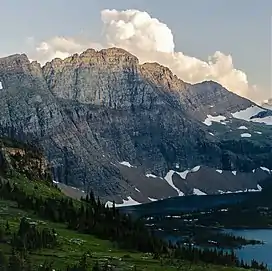| Dragons Tail | |
|---|---|
 Dragons Tail, north aspect | |
| Highest point | |
| Elevation | 8,580 ft (2,615 m)[1] |
| Prominence | 660 ft (200 m)[1] |
| Parent peak | Bearhat Mountain (8,689 ft)[2] |
| Isolation | 1.25 mi (2.01 km)[2] |
| Coordinates | 48°39′25″N 113°44′27″W / 48.656823°N 113.740884°W[1] |
| Geography | |
 Dragons Tail Location in Montana  Dragons Tail Location in the United States | |
| Location | Glacier National Park Flathead County / Glacier County Montana, U.S. |
| Parent range | Lewis Range |
| Topo map | USGS Logan Pass |
| Geology | |
| Type of rock | Sedimentary rock |
| Climbing | |
| Easiest route | class 3 |
The Dragons Tail is an 8,580-foot (2,620-meter) elevation ridge located in the Lewis Range, of Glacier National Park in the U.S. state of Montana. It is situated on the Continental Divide, on the border shared by Flathead County and Glacier County. Topographic relief is significant as the north aspect rises 2,200 feet (670 meters) above Hidden Lake in one-half mile, and the west aspect rises nearly 4,700 feet (1,400 meters) above Avalanche Lake in two miles. It can be seen from the Hidden Lake overlook along with its nearest higher neighbor, Bearhat Mountain, 1.27 miles (2.04 km) to the northwest.[1]
Climate
Based on the Köppen climate classification, Dragons Tail is located in an alpine subarctic climate zone with long, cold, snowy winters, and cool to warm summers.[3] Temperatures can drop below −10 °F with wind chill factors below −30 °F. Precipitation runoff from the west side of the ridge drains into creeks which empty into Lake McDonald, and the east side drains into the St. Mary River.
Geology
Like other mountains in Glacier National Park, Dragons Tail is composed of sedimentary rock laid down during the Precambrian to Jurassic periods. Formed in shallow seas, this sedimentary rock was initially uplifted beginning 170 million years ago when the Lewis Overthrust fault pushed an enormous slab of precambrian rocks 3 mi (4.8 km) thick, 50 miles (80 km) wide and 160 miles (260 km) long over younger rock of the cretaceous period.[4]
Gallery
See also
References
- 1 2 3 4 "Dragons Tail, Montana". Peakbagger.com. Retrieved 2021-08-07.
- 1 2 "The Dragon's Tail - 8,580' MT". listsofjohn.com. Retrieved 2021-08-07.
- ↑ Peel, M. C.; Finlayson, B. L.; McMahon, T. A. (2007). "Updated world map of the Köppen−Geiger climate classification". Hydrol. Earth Syst. Sci. 11: 1633–1644. ISSN 1027-5606.
- ↑ Gadd, Ben (2008). "Geology of the Rocky Mountains and Columbias".
{{cite journal}}: Cite journal requires|journal=(help)









